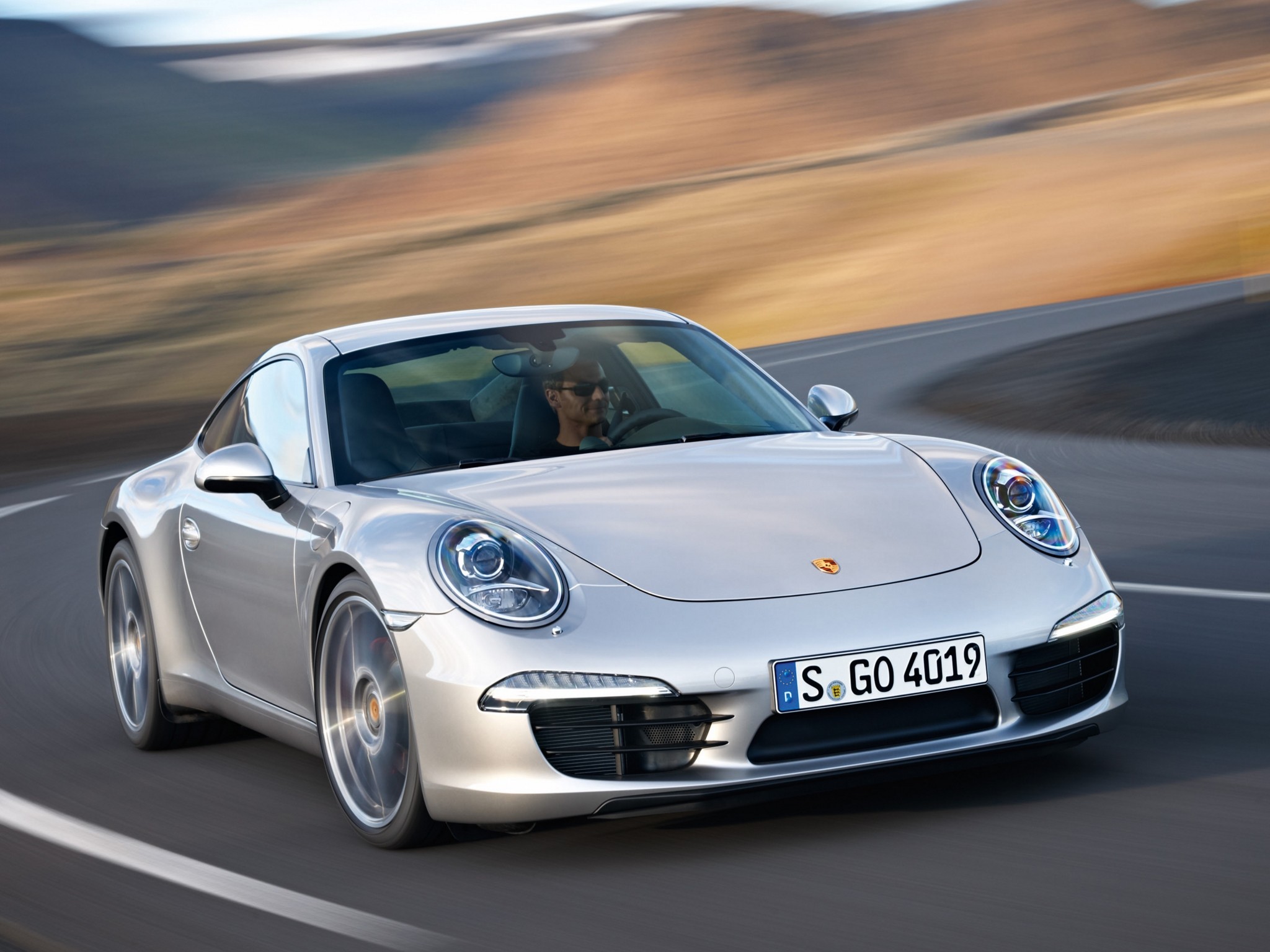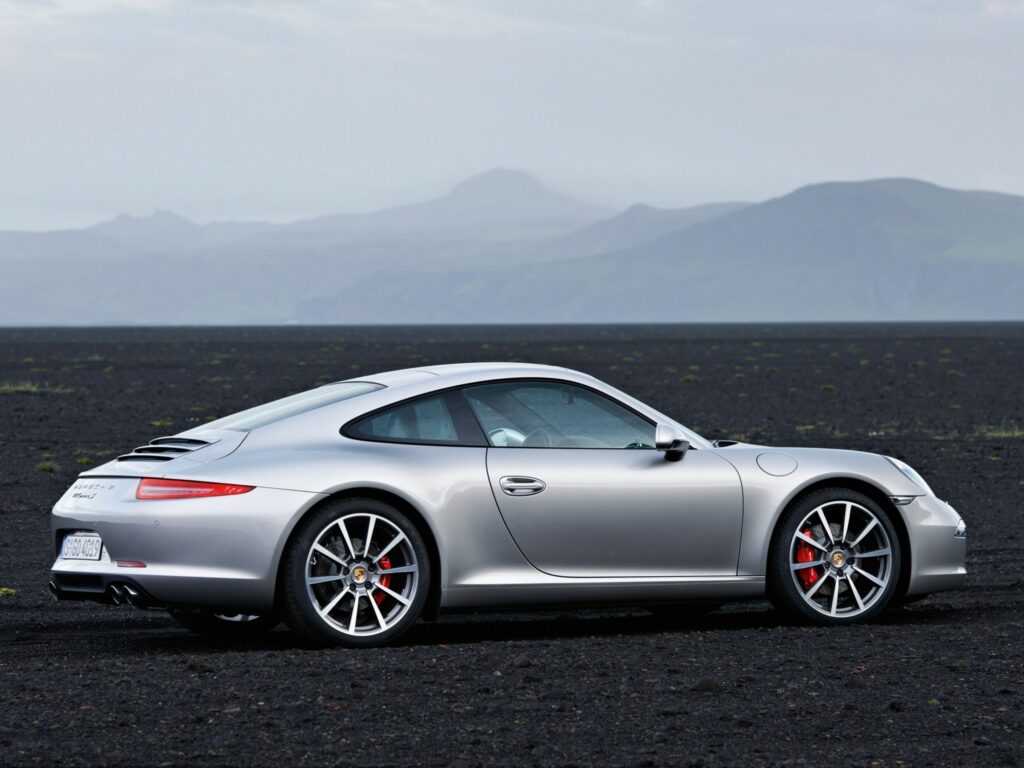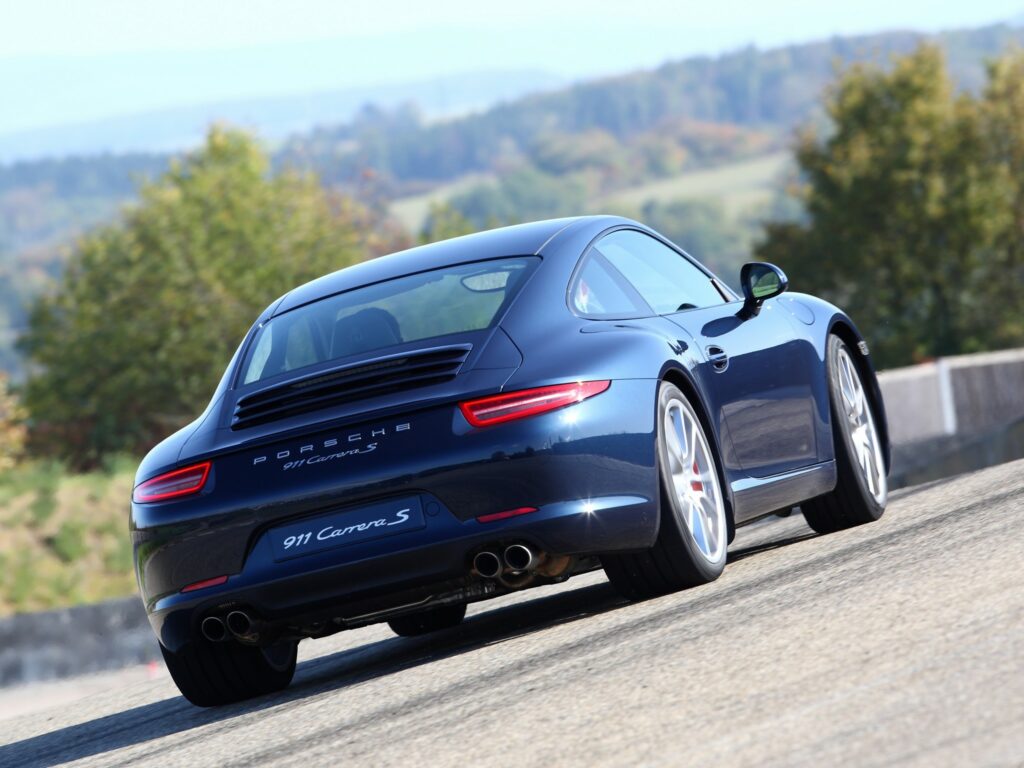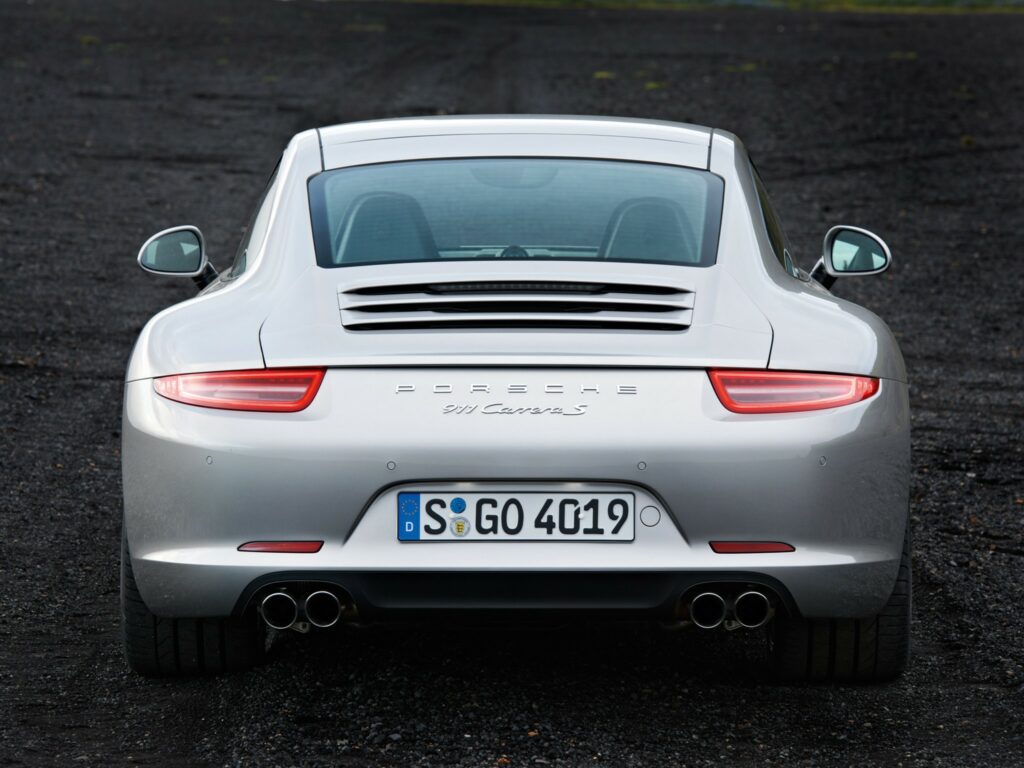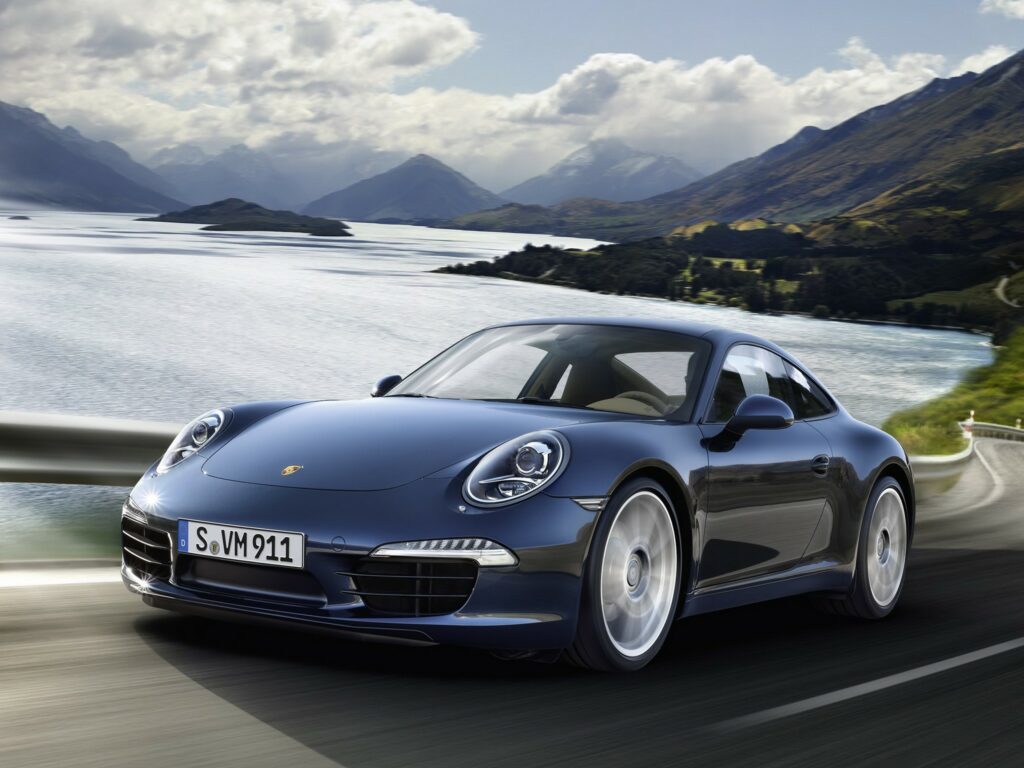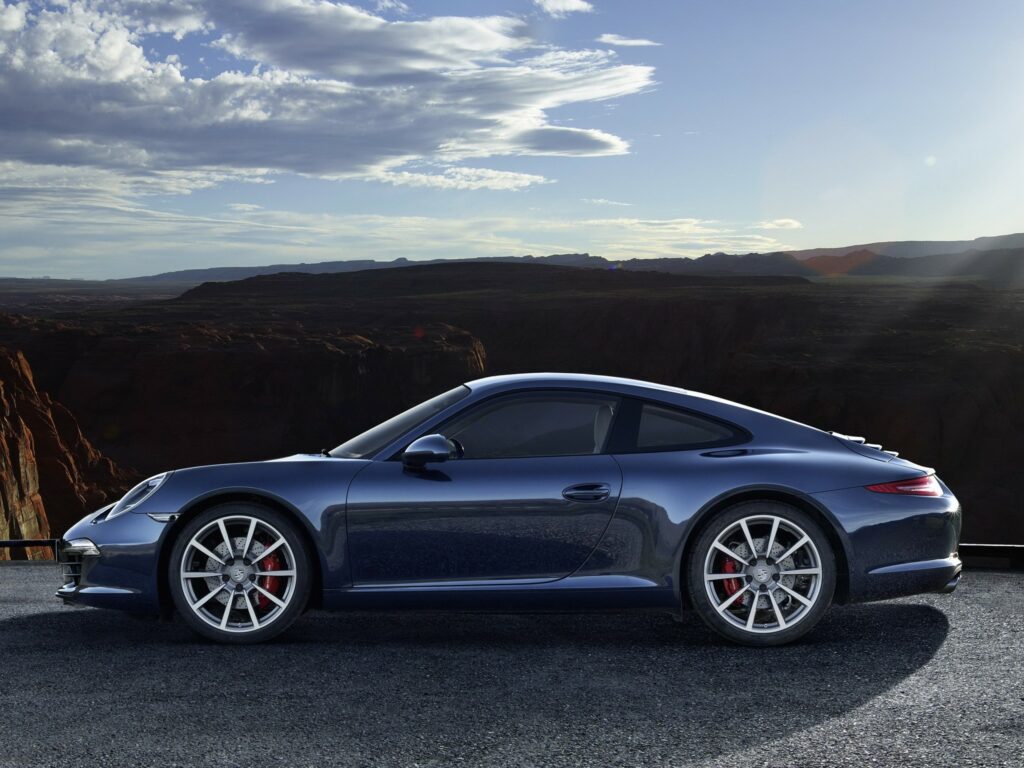(2012 – 2015) Porsche 911 Carrera S (991) – Ultimate Guide
The 991 Carrera S continued the time honored Porsche 911 tradition of growing in physical size and power. Over the years the 911 has continued its evolution from a pure sports car to a luxurious super-car and the 2012 Carrera S Coupe was no exception.
The seventh generation of the 911 launched in 2012 and it sit on a new platform, with a longer wheelbase and shorter overhangs. It also featured new headlights and taillights. Now constructed of almost 50 percent aluminum, including the doors, wings, lids, and roof, the body is about 100 pounds lighter and around 20-percent stiffer, the latter due in part to key uses of ultra-high-strength steel. Further, the body managed to successfully diet while growing more than 2 inches in length (compared to the 997 GTS) and having a wheelbase stretched 4 inches. The overhangs were shortened by 1.3 inches up front and 0.5 inch out back compared to the previous S.
Compared to the 977 generation 911 the engines’ placements reside in essentially the same spots but the 991’s rear axle has shifted 2.8 inches rearward from the driver’s H-point and the front axle 1.2 inches forward. The result? Less weight over the rear, which equals better balance. The Carrera S’s 3309 pounds are distributed 39 percent up front and 61 percent out back.
The 991 Carrera S benefits from lots of other enhancements and changes. The front track has been expanded almost an inch, part of a package using 20-inch wheels with 245/45s up front and 295/30s in back. Now standard on the S is rear limited-slip differential with torque vectoring that applies brake pressure to the inside rear wheel and engine power to the outside rear wheel when cornering, thus upping yaw movement around a turn. Porsche’s $3160 dynamic chassis control — an active roll-stabilization system that helps the car stay flat through corners — and $890 active suspension management, or continuous damping control, are optional.
For the utmost in control and speed, the $1850 Sport Chrono Package is a must, as it includes launch control with the PDK, a Sport Plus button for more aggressive throttle, exhaust, and dampening, and, most important, dynamic engine mounts that keep a leash on the boxer’s centrifugal effect — the engine’s desire to move away from the direction of a turn. Overall, the new Carrera S is better balanced, with a wider front track, bigger tires, and longer wheelbase, and what you get is a four-seater that not only rides smoother and more controlled. A new standard feature, adding to the overwhelming list of acronyms on the 911 Carrera S, is Porsche Torque Vectoring (PTV). With the PDK present, PTV uses an electronically controlled differential lock. This system applies light braking to the inside wheel during quick cornering.
The round headlights with the white DRLs strips underneath, installed on the bumper were one key-feature of the 2012 Porsche 911. The three air-scoops in the bumper amplified the sport look of the vehicle. With its rounded greenhouse that was continued by the engine hood in the back, the seventh Porsche 911 kept its original shape. Behind the engine lid there was an active wing that was risen on highway speeds to keep the car better planted on the road. Porsche stated that the wing was tested up to 300 kph (186 mph) and the car had zero lift.
The interior was more about luxury than about performance. The new instrument cluster still had the center tachometer but on its left there was a TFT display installed into the round circle of the former analog gauge. The navigation system shows multiple map views: top-down, perspective, and even satellite imagery when zoomed too far out to be useful. In perspective view, it renders buildings in 3D in certain city centers. It is just ok to be honest.
The 2012 Porsche Carrera S featured a 3.8-liter flat-six engine. It was mated as standard to a world’s first seven-speed manual transmission. An automatic, PDK (dual-clutch) transmission was offered as an option. The low weight of the car (3,120 pounds), the power of the engine, and the quick-shifting PDK all lead to a 60-mph time of 3.9 seconds. And, just as important, the 911 Carrera S drops speed as fast as it gains it. The car comes standard with six piston brakes up front and four piston brakes on the rear wheels. The stopping power is truly excellent, as modulating the brakes lets the driver precisely slow the car depending on the upcoming turn.
One of the more controversial changes to the 911 comes with Porsche’s adoption of an electric power-steering system. The steering feel is changed significantly, the new system giving point-and-shoot response. Most of the wheel resistance comes with the system’s desire for a wheels-straight position. Some might feel Porsche numbed the steering feel, but, like the PDK, this bit of technology offered easier control of the car in challenging moments. In a push for greater fuel economy, Porsche also added an idle-stop system to the 911, shutting down the engine at stop lights.
Cnet said: The 2012 Porsche 911 Carrera S earns very high marks for its suspension and drive-train technologies. The electronics add to the handling without being intrusive, while the transmission shows it can deal with both performance and daily driving. And fuel economy, at least in the EPA tests, is better than you see from any other car with this level of performance. The 911 Carrera S is less spectacular when it comes to cabin electronics.
Pictures
Press Release
Porsche is proud to present the new Porsche 911 Carrera, a completely new generation of the iconic coupe that has been acclaimed as one of the world’s benchmark sports cars since its launch in 1963.
Tradition meets modernity
True to the 911 tradition, the distinctive Porsche design language exudes power and elegance. The unmistakable silhouette still catches the eye while incorporating new, exciting contours and precisely designed details; a 100mm longer wheelbase for improved stability and greater interior space; front and rear overhangs are shorter, maintaining the compact footprint that has been a longstanding 911 attribute; the sporting stance is emphasised by the lower roof line and a wider front track increases on-road presence further still while raising the renowned chassis dynamics.
The rear-mounted, flat six cylinder engine is an equally symbolic component of the 911 identity; and behind the rear axle of the new car lies an uprated range of powerful, efficient and evocative ‘boxer’ engines. The Porsche 911 Carrera is powered by a new 3.4-litre engine developing 350 hp, and the Carrera S features a 400 hp version of the familiar 3.8-litre. These new engines offer performance improvements for both models. The 3.4-litre Carrera with PDK accelerates from 0-62mph in 4.6 sec, 0.1 sec quicker than the prior model. Pressing the Sport Plus button on the optional Sport Chrono Pack cuts that to 4.4 sec. The 3.8-litre Carrera S with PDK can accelerate from 0- 62 mph in 4.3 sec (Sport Plus 4.1 sec), 0.2sec quicker than its predecessor.
All-new lightweight body
Principle among the innovative steps forwards is the all-new, lightweight body, featuring intelligent aluminium-steel composite construction. It is responsible for a significant proportion of the vehicle weight reduction of up to 45 kg. The body structure also delivers significantly greater rigidity, and aerodynamic optimisation – including a wider, variably extending rear spoiler – has reduced the lift generated by the new 911 Carrera while retaining an impressive overall drag factor.
Innovative chassis technology
That the new 911 offers better acceleration in a straight line goes without saying, but it also offers top performance at an unprecedented level across the entire dynamic repertoire. In addition to the longer wheelbase, the greater agility, precision and driving stability are based, among other things, on the wider front track, a new rear axle and new electro-mechanical power steering.
Depending on the model, there are other standard or optional active control systems available as well that further enhance the driving dynamics. That is especially true for the Porsche Dynamic Chassis Control (PDCC) active roll stabilisation system, available for the first time on the Porsche 911 Carrera S. The system reduces body roll when cornering, with the result that the tyres are always in the optimal position relative to the road surface and thus able to transmit higher lateral forces. Consequently, maximum cornering speeds are increased, and even faster lap times on racing circuits are possible.
Exterior design
The familiar athletic appearance of the 911 is given further dynamism with a 100mm longer wheelbase, reduced height, and up to 20-inch diameter alloy wheels. At the same time, the typically compact exterior dimensions have been retained. Seen from the front, the eye is drawn to the trademark wide-arched wings, emphasising the wider front track and making the new 911 Carrera models adopt a particularly sporting stance on the road. The redesigned exterior mirrors are now mounted on the upper edge of the door and not as before on the mirror triangle. Not only is this aerodynamically advantageous, it also emphasises the new design line and visual impression of width.
Interior design
To complement the modern exterior, the Porsche designers created an interior style which takes its cue from that of the Porsche Carrera GT. The driver is now even more closely integrated with the cockpit thanks to the centre console rising up to the front with the high-mounted shift lever – or PDK gear selector – located close to the steering wheel in typical motorsport fashion. Classic Porsche style elements are also to be found inside, just as they are on the outside. For example, the instrument cluster with five round instruments, with the central dial naturally the rev counter. On the right is a new, high resolution multi-function screen, just one of the comfort features added to meet evolving customer demands.
Porsche Intelligent Performance
Setting the standard in its class, as it has for generations, the new Porsche 911 Carrera and Carrera S raise the performance and efficiency standard to new levels. Fuel consumption and emissions of all versions are up to 16 per cent lower compared with its predecessors. Among other things, this is achieved by systems and functions such as auto start/stop, thermal management, electrical system recuperation, the world’s first seven-speed manual transmission and – in conjunction with the Porsche-Doppelkupplungsgetriebe (PDK) – a ‘coasting’ function that decouples the engine for enhanced fuel efficiency when the throttle is closed.
The new electro-mechanical power steering system offers not only the typical precision and feedback expected of a Porsche, but also helps to increase efficiency and reduce fuel consumption. For example, the Porsche 911 Carrera with the new 350 hp (257 kW) 3.4-litre direct injection engine and optional PDK returns 34.4mpg Combined based on the New European Driving Cycle (NEDC) – 6mpg less than its predecessor. Also, at 194 g/km CO2, it is the first Porsche sports car to sit below 200 g/km CO2. In the case of the Carrera S, with its 400 hp 3.8-litre direct injection engine, economy when paired with the optional PDK is increased by 14 per cent, or 5 mpg, to 32.4mpg Combined despite 15 hp more power. That equates to CO2 emissions of 205 g/km.
Evidently, it has therefore been possible in the new 911 Carrera to extend yet further the span of apparently contradictory attributes such as performance and efficiency, sportiness and everyday usability that has always typified the Porsche 911. It could be said that the new 911 Carrera is thus more of a 911 than ever.
In the UK from December 2011
The new Porsche 911 Carrera celebrates its world premiere at the 2011 IAA Frankfurt Motor Show and the new 911 models will be in UK Porsche Centres from December 17 2011.
The Porsche 911 Carrera is priced from £71,449 and the Porsche 911 Carrera S is priced from £81,242. Standard equipment on all models is leather interior, sports seats, automatic climate control, Bi-Xenon headlights, 7-inch colour touch-screen Porsche Communication Management with satellite navigation, a universal audio interface offering MP3 connectivity, Porsche Stability Management (PSM) and a three year warranty.
The Carrera S adds 20-inch alloy wheels, Porsche Active Suspension Management (PASM) and Porsche Torque Vectoring (PTV) with rear limited slip differential, in addition to the power advantage of the larger 3.8-litre engine.
Fitted to every 911 is a Porsche Vehicle Tracking System (VTS), a sophisticated vehicle security package approved to Thatcham Category 5 standard, and customers will also be able to explore the potential of their new car by participating in a complimentary course at the Porsche Experience Centre, Silverstone.
Powerkit Option
Stuttgart. For its exceptionally performance-oriented customers, Porsche Exclusive now offers a new power enhancement kit developed for the 911 Carrera S. It focuses specifically on the dynamic properties of the sports car. It boosts the power of the 3.8-litre boxer engine from 400 hp (294 kW) to 430 hp (316 kW), producing even better driving performance.
Thanks to this Powerkit, the 911 Carrera S Coupé only needs 4.0 seconds to sprint from zero to 100 km/h with PDK in Sport Plus mode. The kit also increases the top speed by four km/h: to 306 km/h with PDK and to 308 km/h with a seven-speed manual gearbox. However, the enhanced power has not affected fuel economy: fuel consumption values in the NEDC are unchanged despite a power increase of over seven per cent.
More power without higher fuel consumption is made possible by carefully tuned modifications and adaptations to the electronic engine management. The core elements of the Powerkit are special cylinder heads with different camshafts and an entirely new variable resonance intake system design with six air flaps and a resonance flap. An additional centre radiator keeps the higher specific power from overloading the thermal management system of the six-cylinder engine.Low exhaust back pressure is achieved by the sport exhaust system that is equipped with two sets of twin tailpipes with independent styling; this system is also included with the Powerkit. At the press of a button, the exhaust system is de-throttled, the two exhaust lines are merged and they generate a powerful engine sound.
The Powerkit also includes the Sport Chrono package with dynamic engine mounts for even sportier driving properties. A visual trademark of the Powerkit is the car’s modified engine compartment styling with titanium coloured engine cover and carbon inlays.
Porsche Exclusive also offers aerodynamically tuned exterior components that offer customisation over various expansion levels. The basic component is the front apron that extends low and has powerful air intakes from the Sport Design package. This package also includes a fixed rear spoiler in legendary “ducktail” form. The top upgrade is the Aerokit Cup with an additional fixed rear wing over the rear spoiler and a special front spoiler lip with additional air intakes. Other new Porsche Exclusive products for the 911 Carrera include tinted privacy glass for the side and rear windows and the Exterior package with various components in body colour. Inside, Porsche Exclusive also offers numerous upgrades such as interior packages with decorative trim ranging from brushed aluminium to carbon.


